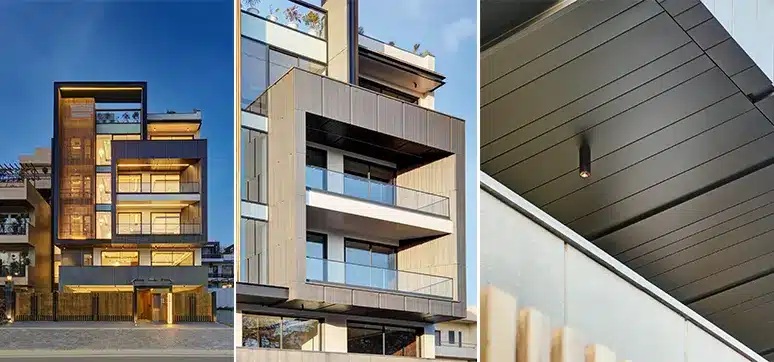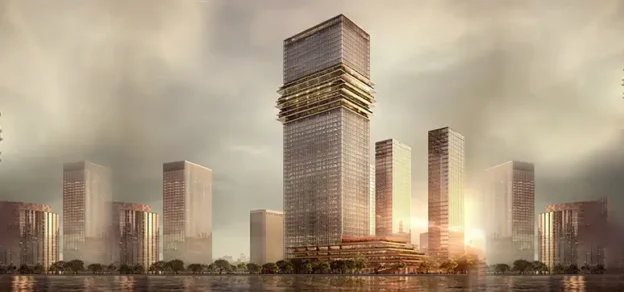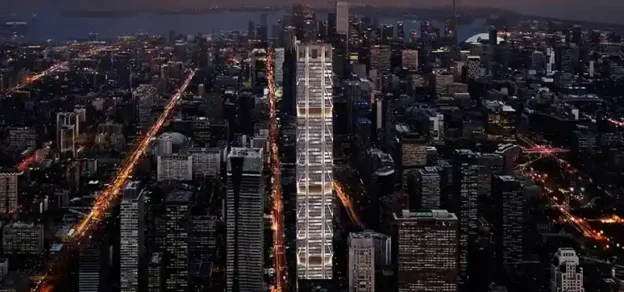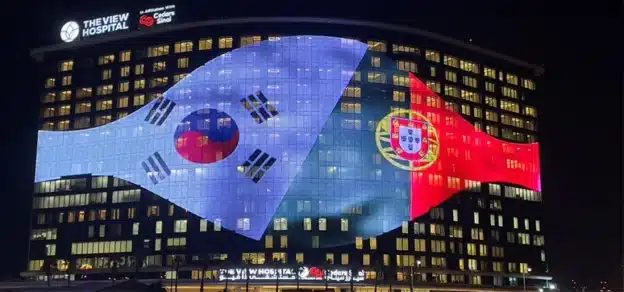The Energy Conservation Building Code (ECBC) and Leadership in Energy and Environmental Design (LEED) recognise green building certification systems and provide verification that a building or community was designed and built using strategies aimed at improving performance, their interpretation for façade design remains largely unexplored in India.
Presently, innovations in façade design across the Indian landscape are limited to the use of double-glazing and cavity walls as strategies for energy efficiency; however, these may not always be effective and resilient in the long term. One solution that shows promise is designing façades as living environments with habitable spaces. To achieve mean temperatures, these spaces can integrate cooling systems by taking the return air from internal air-conditioned spaces through the façade skin, and back into the Air Handling Units (AHU).
House Under Shadows
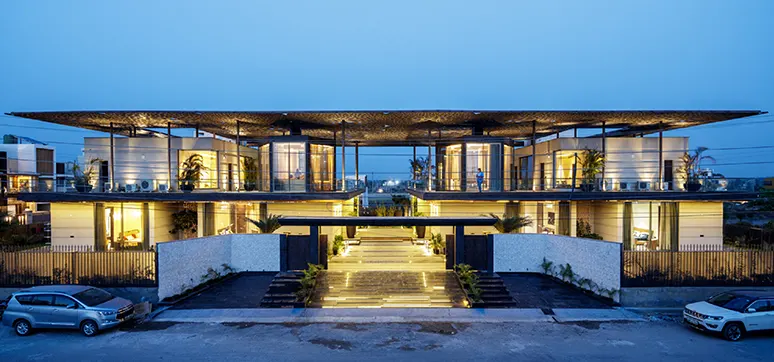
The name suggests a house ornamented in the moving shadows of the day creating a symphony between the user and the sun, the powerhouse of energy. The client’s brief was to build two separate units for a family of two brothers that characterises sustainable living in the lap of nature. Taking cues from the context of Noor Mahal Palace and chattri with a courtyard punctured between the houses, we were able to create a mini ecosystem for the family to live under the harsh weather in Karnal, Haryana. The major source of heat gain is from the roof and then from the walls.
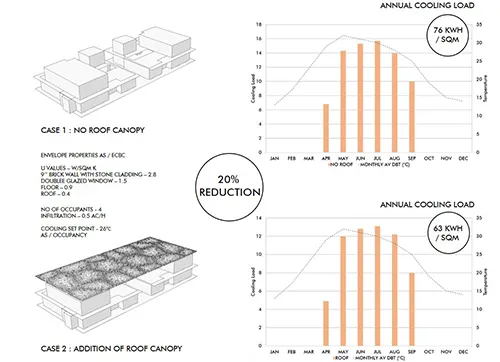
Both the surfaces were treated with architecture elements to create shade. A parametrically digitalled roof of voronoi pattern was used to reduce direct and diffused radiations by 50% on the primary roof. This created an expansive common area on the terrace to enjoy during summer evenings and winter mornings. This pergola on top provides a shaded entrance which prevents heat shock while entering the house. Secondly, the walls were shaded with large spanning cantilevers on all sides to avoid heating of the vertical thermal mass. Major fenestrations in the walls were placed in the internal courtyard side while the external windows were shaded with the help of cantilevers.
All the spaces are daylit avoiding the use of artificial lighting during the day. The major heat comes in the form of direct, diffused radiation and through conduction and convection of materials. The above two factors were cut by the most basic element; the chajja and conduction were kept to a bare minimum by using double glazed windows of high U value. Also, the glazing was airtight so as to reduce the flow of convection currents. The interior layout is designed to ensure abundant cross ventilation and natural light within spaces based on their usage.

Thus, bedrooms with sleeping/resting spaces that are mostly used during the night are orientated towards the south-west, while living spaces used during day face the north east. The bedrooms’ glazing is towards the north-west and it receives no sun during the day to create a cool oasis for unwinding, while offering expansive views of the landscape. The living spaces owing to their strategic placement stay protected from the harsh south-west sun and open towards the courtyard to minimise heat gain and enjoy natural daylight as well.

In summers, one can open the windows towards the courtyard side to enjoy the cool micro-climate created inside the house with a pool, vertical greens and a shaded double height pergola on top. In monsoons, one can open the exterior as well as interior windows to allow cross ventilation in the humid climate. While in winters, one can enjoy the low-lying sun in the morning which cuts across the cantilever and lits up the interior spaces providing warmth.
While transition spaces bring in natural ventilation and daylight, stone-clad walls provide thermal mass insulation and vertical gardens create heat sinks, all of which contribute to the maintenance of a constant temperature throughout the home. The pool serves not only as a landscape feature but also contributes to absorbing day-time heat and releasing it to the night sky, lowering the net heat gain.
Future of Façade Design
In recent times, parametricism in India has been slowly echoing the theme of the modern architectural language. The term ‘parametric’ is derived from parametric equations which refer to the use of certain parameters that can be modulated to alter the result of an equation or a mathematical system. Through preliminary studies and analyses, façade requirements, say for a residence (the required penetration of solar radiation, size and nature of fenestration, material insulation etc.) are calculated.

The façade is then designed using an integrated system that utilises the environmental analysis and thermal mass optimisation backed by computational analysis. This is enabled through Rhino, Grasshopper and Ladybug (parametric design software based on algorithmic inputs that define design rules) through which a script is written to analyse the level of direct and diffused radiation on the primary façade.

Conventionally, façade design iterations are modelled on their own accord, and environmental analysis tools are used for validation in the later stages of design. However, such a workflow creates a disconnect of energy optimisation between the façade and the internal built form.

QUICK FACTS:
Project: House Under Shadows
Location: Karnal, Haryana, India
Name of Client: Mr Sahil Gandhi
Typology: Residential
Principal Architect: Zero Energy Design Lab
Design Team: Lead: Sachin and Payal Rastogi
Site Area (sq ft & sq m): 16,216 sq ft
Built-Up Area (sq ft & sq m): 1672 sq m
Start Date: March 2018
Completion Date: March 2021
Photographer: Noughts and Crosses | Andre J. Fanthome
